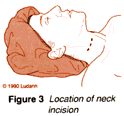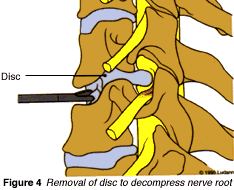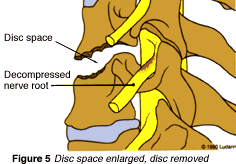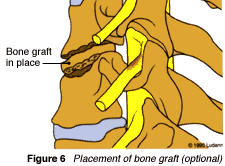The Operation
Incision:
Surgery for anterior cervical discectomy is performed with the patient lying on his or her back. A small incision is made in the front of the neck, to one side (Fig. 3).
Exposure and removal of the herniated disc
After fat and muscle are pulled aside with a retractor, the disc is exposed between the vertebrae. An operating microscope may be used as part of the disc is removed with a forcep (Fig. 4).

Specialized instruments or a surgical drill may be used to enlarge the disc space (Fig. 5). This will help the surgeon to empty the disc space fully and relieve any pressure on the nerve or spinal cord from bone spurs or the ruptured disc.

Placement of the bone graft
If your surgeon has chosen to use a bone graft, it will be placed in the disc space to help fuse the vertebrae it lies between (Fig. 6). Any of several graft shapes may be used.

Incision closure
The operation is completed when the neck incision is closed in several layers (Fig. 7). Unless dissolving suture material is used, the skin sutures (stitches) or staples will have to be removed after the incision has healed.

Risk
Certain risks must be considered with any surgery. Although every precaution will be taken to avoid complications, among the most common risks possible with surgery are: infection, excessive bleeding (hemorrhage), and an adverse reaction to anesthesia.
Other risks possible with anterior cervical discectomy include: stroke; injury to the recurrent laryngeal nerve, which causes hoarseness and may or may not be permanent; and injury to the involved nerve root(s) or the spinal cord, both of which can cause varying types and degrees of paralysis.
Clinical experience and scientific calculation indicate that, in general, surgical risks are limited; however, surgery remains a human effort. Unforeseen circumstances can complicate any surgical procedure and lead to serious or even life-threatening situations. Although such complications are infrequent, you and your family should feel free to discuss the question of risk with your physician.